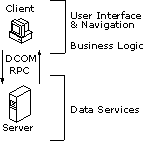Developing Web Applications |
Cooperating and communicating applications have typically been categorized as either client or server applications. While the client application requests services using Microsoft® Distributed Component Object Model (DCOM) or remote procedure calls (RPCs), the server application responds to client requests. Traditional client/server interactions, shown in the figure below, are often data-centric and combine most (if not all) of the processing (or business) logic and user interface within the client application. The server’s task is simply to process requests for data storage and retrieval.

Client/server (two-tier) applications have usually performed many of the functions of stand-alone systems; that is, they present a user interface, gather and process user input, perform the requested processing, and report the status of the request. Because servers only provide access to the data, the client uses its local resources to process it. Out of necessity, the client application can tell where the data resides and how it is laid out in the database. Once the server transmits the data, the client is responsible for formatting and displaying it to the user.
The primary advantage of two-tier applications over monolithic, single-tier applications is that they give multiple users access to the same data simultaneously, thereby creating a kind of interprocess communication. Updates from one computer are instantly available to all computers that have access to the server.
However, the server must trust clients to modify data appropriately—unless data integrity rules are used, there is no protection against errors in client logic. Furthermore, client/server connections are hard to manage—the server is forced to open one connection per client. Finally, because much of the business logic is spread throughout a suite of client applications, changes in business processes usually lead to expensive and time-consuming alterations to source code.
Although two-tier design still continues to drive many small-scale business applications, an increasing need for faster and more reliable data access, coupled with decreasing development time lines, has persuaded system developers to seek out a new distributed application design.